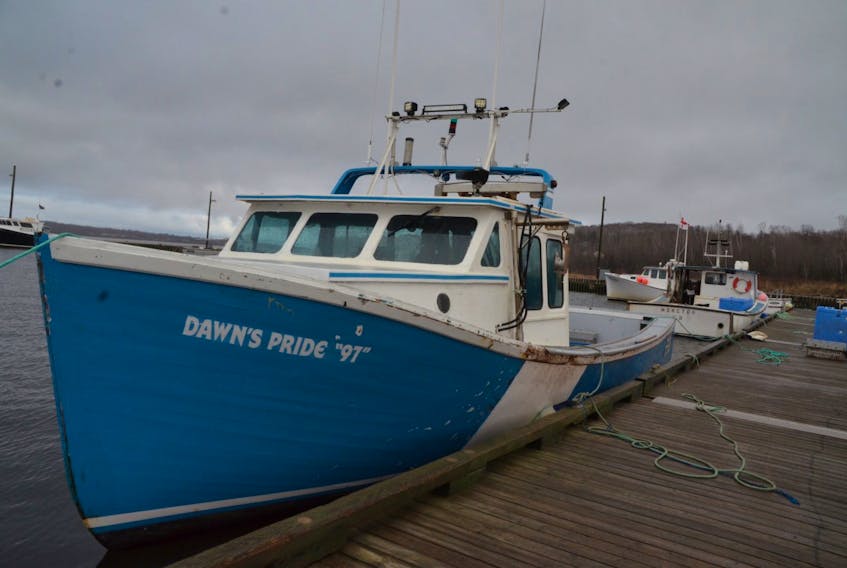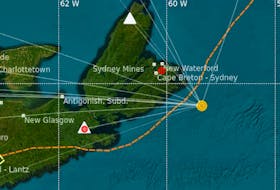PICTOU LANDING, N.S. — Strong westerly winds kept the four Cape Islanders behind the Pictou Landing wharf’s breakwater on Tuesday.
“We’re not trying to hide anything,” said Zack Nicholas, who owns one of the boats.
“DFO can watch us coming and going from their office.”
The commercial season for lobster fishing on the Northumberland Shore runs through May and June.
Non-aboriginal commercial fishermen have been watching from their homes and wharves the four boats from Pictou Landing setting and hauling gear.
“I told my son, ‘Don’t go cutting traps because you’ll get arrested and they’ll just put more traps out,'” said one non-aboriginal fisherman.
On the Eastern Shore, a non-aboriginal fisherman who also didn’t want his name used described the situation as “a loaded gun waiting to go off.”
Twenty years after the Supreme Court of Canada acknowledged the Mi’kmaq have a treaty right to make a “moderate livelihood” from natural resources, negotiations drag on with Fisheries and Oceans Canada over what that would look like.
Meanwhile, a co-ordinated effort has emerged among the Mi’kmaq to move ahead with the fishery, develop their own management plans and let Fisheries and Oceans respond.
In the absence of a federal response. tensions are rising.
Boats on the water
“I’d welcome it,” Nicholas said of getting arrested by Fisheries and Oceans Canada.
He’d welcome it because then it would go to court.
And the country’s highest court ruled in the Marshall Decision that Mi’kmaq have a treaty right to make a moderate livelihood from the fishery.
Fisheries and Oceans Canada has done everything it can to avoid arresting him while still trying to interfere in his fishing.
For a moment in September, he thought he might get arrested.
He and four other Mi’kmaq fishermen had landed 32 crates of lobster at a wharf in Digby County.
“DFO came up and said, ‘You’re all under arrest,'” recalled Nicholas.
“We handed them our status cards and said, ‘What for?’ So then they came out with their famous line, ‘Now you’re under investigation,' and seized our lobster for 90 days.”
That 90 days is coming due and Nicholas wants his 32 crates — each on average containing 45 kilograms of lobster — back.
Nicholas came back to Pictou Landing and along with five other crews started fishing the Northumberland Shore. That’s down to four boats right now.
Two weeks ago, Fisheries and Oceans Canada hauled and seized 100 of their traps from the water.
On the weekend, fisheries officers intercepted and seized lobster caught at the wharf from a buyer.
But still no Mi’kmaq fishermen have been charged.
Uncertain legal waters
After the Supreme Court ruled that according to treaties signed between the Mi’kmaq and British Crown in 1760 and 1761 that Donald Marshall Jr. had a treaty right to sell the 210 kilograms of eels he caught in Pomquet Harbour without a licence, something near chaos ensued on the water.
Mi’kmaq fishermen took to the waters of Atlantic Canada to exercise their treaty rights.
Non-aboriginal fishermen who had purchased expensive licences and were already competing over heavily taxed natural resources reacted.
They blockaded harbours and a powder keg appeared ready to explode.
Three months after making its ruling, the Supreme Court took the rare step of issuing a clarification, saying that the federal government had the right to manage fisheries for conservation purposes and that the Mi'kmaq only had a treaty right to participate commercially in traditional fisheries.
Fisheries and Oceans Canada was on its heels and responded with what it agreed was a stop-gap measure. Over the seven years that followed the Marshall Decision, it spent $600 million buying licences and gear from non-aboriginal fishermen at often inflated prices and handing them over to First Nations as communal community licences.
In total, 32 of 34 eligible First Nations signed commercial access agreements with the federal regulator of the fishery in exchange for licences and boats.
“When providing this commercial access without prejudice (DFO) said this was just an interim practical measure and there would be a subsequent process to negotiate about their treaty rights,” said Bruce Wildsmith, lawyer for the Mi'kmaq Rights Initiative.
The licences provided a way for First Nations to create employment for their membership and money to fund community operations. They didn’t address the right of individual Mi’kmaq to catch fish and sell them.
On Wednesday, Wayne Denny was on dry land surrounded by the Pictou Landing fishing fleet, along with its traps and gear inside a gated compound.
“It’s too much of a liability to be putting boats out like that,” said the First Nation’s fisheries director of the moderate livelihood fishery.
The band owns and fishes 23 lobster licences and 11 crab licences that employ 90 of its members seasonally and generate millions of dollars of revenue annually for the community.
His fishermen haul traps in the spring alongside boats from surrounding non-aboriginal communities.
“Yes, of course,” he said when asked if he's worried about the effect of individual band members pursuing a moderate livelihood fishery would have on relations with non-aboriginal fishermen.
“I wish this was all resolved yesterday.”
In 2002 and then in 2008 agreements were signed between the federal regulator and Mi’kmaq Rights Initiative that set the groundwork for the negotiations on the creation of a moderate livelihood fishery.
In August, two First Nations in New Brunswick signed agreements with the federal government regarding moderate livelihood fisheries.
“In simplest terms it was here’s money to buy commercial access that you will fish under commercial rules and that will be for your members their moderate livelihood for a period up to 10 years pending further negotiations,” said Wildsmith.
“It’s fair to say the agreements Illustrate (the federal government’s) preferred approach — provide money for commercial access in exchange for not exercising your rights … that’s not acceptable to the Assembly of Nova Scotia Mi’kmaq Chiefs.”
Eyes on the water
Over the past two decades Clarence Arbuckle has gone from 300 traps to 255.
He’s increased the minimum size of lobster he can keep and he’s begun throwing back valuable female lobsters of a particular size known as ‘windows’ because biologists have said they are the most prolific breeders.
That’s on top of a pile of other conservation measures fishermen along the Northumberland Shore have voluntarily agreed to.
“It seems to be working for us because now with less traps we’re probably catching more lobster,” said Arbuckle, who fishes from Arisaig, Antigonish Co.
“As a combination they’ve made our whole industry more sustainable.”
A licence and gear for the two-month-long fishery along the Northumberland Strait can go for a half million dollars depending on which harbour you’re buying it from.
That price is largely based on recent landings and for new entrants comes with significant interest payments.
It is a highly capitalized industry based upon a resource that doesn’t crawl very far from where you threw it overboard with the expectation that what you don’t land this year will increase your catch the following season.
Arbuckle and other fishermen, most of whom have survived in part on the resource for generations, are now watching a new entrant fish by their own rules.
“What if next fall instead of three boats there are thirty boats out taking the stock you left there,” said Arbuckle.
“… I don’t want my boat involved in trying to go out and having to do something. Somebody’s got to pull up their pants and make a stand and it’s got to be the federal government.”
For his part, Nicholas said Mi’kmaq fishermen are following their own conservation measures.
They’re only landing market sized lobster.
The escape hatches on the traps are the standard size used during the commercial season and they’ve limited themselves to 100 traps per boat during their moderate livelihood fishery.
They also don’t fish during the summer when lobster are moulting.
“The moderate livelihood fishery is in the very early stages of developing our own management plan,” said Nicholas.
Asked what he’d say to non-aboriginal fishermen concerned with this fall fishery he replied, “If they were able to do it they’d be out there too.”
Arbuckle and Nicholas agree on two things.
They don't want the situation to turn violent.
And also that absent of settled rules of the water that all parties are held to, they don't know what's going to happen next.
Fisheries and Oceans Canada did not provide a response by deadline Wednesday.









